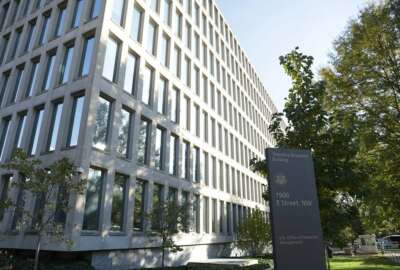1,400 EEOC employees will return to the office, but union negotiations still ongoing
The Equal Employment Opportunity Commission announced reentry deadline for its union employees, but the agency’s in-person plans remain undetermined beyond 20...
With union negotiations still unresolved, the American Federation of Government Employees is calling on the Equal Employment Opportunity Commission to slow down its office reentry plans.
Approximately 1,400 union-covered EEOC employees can expect to begin partially returning to physical office spaces on May 16, answering the question of when the remaining fully remote employees will transition to hybrid work.
That comes after senior leaders, supervisors, managers and about 650 non-bargaining employees at EEOC returned to at least some in-person work in phases between March 28 and April 11.
The agency and the union were working on a reentry agreement called a memorandum of understanding (MOU) for EEOC’s union employees. But AFGE said the agreement was still incomplete when EEOC told its employees on May 5 that doors would open later this month.
In response, the union filed an unfair labor practice complaint regarding the agency’s return-to-office plans.
“We felt that we were close to a deal,” Rachel Shonfield, president of AFGE council 216, which represents EEOC employees, said in an interview with Federal News Network.
In an AFGE press release on May 9, Shonfield also said that she is “completely opposed” to bargaining taking place after reentry occurs.
“It doesn’t make sense to have reentry negotiations after reentry,” she said in an interview with Federal News Network.
The MOU outlined a phased reentry approach for EEOC, which would start with moving into the office for areas with low community transmission rates for COVID-19, then add in areas with higher transmissions rates week by week.
Shonfield said EEOC’s announcement to its employees did not include any mention of the phased approach.
In addition to the phased reentry, AFGE is trying to bargain for an orderly and neutral selection process for in-office work schedules, regular field office safety inspections, contactless intake of patrons and expanded telework and remote work flexibility.
But EEOC’s reentry announcement to its employees will cause issues in negotiations, Shonfield said.
“This action by the agency is already causing chaos by upending the safe and orderly processes that the union was in the midst of bargaining when the agency instead short-circuited negotiations,” she said in the AFGE press release.
For EEOC employees returning to the office on May 16, they will work in person for at least one day per week for the first month. Then in-person work will increase to at least two days per week. The two-day format will last through the rest of this calendar year, EEOC Communications Director Victor Chen told Federal News Network.
Reentry plans after this calendar year hang in the balance. So far, EEOC has made no decisions about telework, remote work or other workplace flexibilities beyond this December, Chen said.
The Dec. 31 deadline is “arbitrary,” Shonfield said. She recommended that EEOC use a “commonsense” telework expansion to allow employees the flexibility to come in only when they have public-facing duties, such as working with customers.
“A lot of other agencies are increasing telework from their pre-pandemic programs, but EEOC is offering just a short-term increase. It’s sort of like a mirage,” she said.
The days that employees will be expected to work in person varies between offices and is based on factors like location and staffing levels.
“It is important that the EEOC reopen our doors, reestablish our physical presence in the communities we serve and provide critical services to vulnerable employees and applicants who most need our help,” Chen said.
Throughout the COVID-19 pandemic, EEOC has struggled to reach some underserved communities that have limited access to digital services.
“The biggest gap in serving the public during the pandemic has been not being able to reach or be accessible to some of the most vulnerable workers, many of which are in rural communities, communities of color, immigrant communities and other places where internet access may be limited,” Chen said.
Some lawmakers have previously expressed similar concerns that EEOC cannot efficiently review and resolve discrimination charges with large-scale remote work.
But Shonfield said that much of EEOC’s public-facing work was done by phone even before the COVID-19 pandemic.
There are still some unresolved issues that the agency and AFGE are working through. The agency will continue union negotiations over the impact of reentry plans on employees.
“These issues are primarily related to the EEOC’s ability to serve the public in person, the number of days employees need to report to the office per week and the length of time before bargaining unit employees need to begin reentry,” Chen said.
The current reentry plan expires at the end of 2022. The agency will use its 2022 reentry as a test run to inform changes to its in-person work policies for next year.
“We will be assessing the efficacy of a hybrid workplace and any technological and structural changes needed to ensure we’re meeting the needs of the public we serve,” Chen said.
Copyright © 2024 Federal News Network. All rights reserved. This website is not intended for users located within the European Economic Area.
Drew Friedman is a workforce, pay and benefits reporter for Federal News Network.
Follow @dfriedmanWFED






